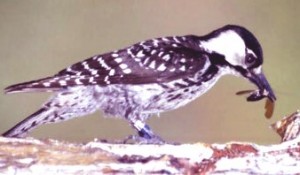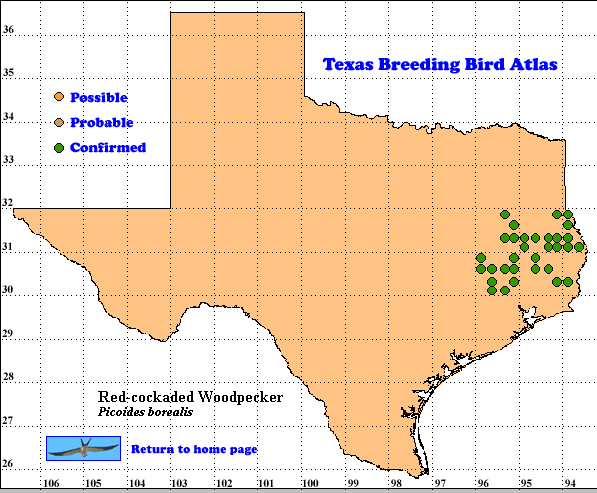Once found in mature open pine forests throughout the southeast. U.S. from e. Texas to Maryland, the Red-cockaded Woodpecker has declined to as few as 10,000 birds and populations are highly fragmented. Jackson (1994) reviews this woodpecker’s ecology and status range-wide.
In Texas, Red-cockaded Woodpeckers remain most common on public lands, especially on national forests, where studies found cavity cluster losses and abandonment associated with timber harvesting on Texas national forests (JAJ). Concern for declines of the species on Texas national forests during the 1970s and 1980s (Conner and Rudolph 1989) brought about a landmark legal decision, upheld on appeal, that stopped all clear-cutting on these forests (Larmer, pers. comm.). Although not so well documented, Red-cockaded Woodpeckers have probably declined most rapidly on private lands (Ortego and Lay 1988, B. Ortego, pers. comm.).
DISTRIBUTION: TBBA data include records for the Red-cockaded Woodpecker from 31 quads in east Texas. Because of its Endangered status and occurrence on federal and state lands, excellent records are available to supplement TBBA records. TBBA data define the heart of the area occupied by the species, an area of concentration also identified in Oberholser (1974). Lay (1969) provided evidence that this species once occupied as many as 40 east Texas counties; by 1968 they were restricted to 9 counties.
SEASONAL OCCURRENCE: Red- cockaded Woodpeckers are permanent residents throughout their range and an adult male is strongly associated with its cavity tree cluster, often remaining with it even if surrounding forest is cut, or returning to it if he is captured and moved elsewhere. A young male is also linked to a specific site, usually remaining with his parents and serving as a “helper” for a year or more. A helper assists with cavity excavation, incubation, and feeding of young. A female disperses from the cavity tree cluster and her clan (family group) during her first winter. She wanders in the population until she locates an unmated male with a cluster of cavity trees where there is no female. Within each clan there is normally a breeding male and female and one or more helpers. The clan forages together, characteristically requiring about 200 acres (81 ha) of older, open pine forest habitat. Because of their large home range, Red-cockaded Woodpeckers are often difficult to locate at midday and most easily observed near the roost at dawn or dusk. When young are in the nest, typically in April and May in Texas, the home range decreases substantially, often to 30-50 acres (12-20 ha) so that adults might bring food frequently enough to raise their young.
BREEDING HABITAT. Red-cockaded Woodpecker nests are in cavities excavated into heartwood of living pines. They typically excavate several cavities within a cluster of trees because each bird needs its own cavity to roost in at night. These are conspicuous because of small holes, resin wells, that these woodpeckers peck above and below the cavity entrance, causing gum to flow down the trunk. This gum deters climbing rat snakes. A reddish color around resin wells and cavity entrance suggests recent work by the birds and active status for the cavity tree (Jackson 1994).
The cluster of cavity trees and extensive open pine forest foraging area are essential to the survival of the group. Old growth long-leaf pine (Pinus palustris) is favored where it occurs, but Red-cockaded Woodpeckers also use short-leaf (P. echinata) and loblolly pine (P. taeda) in Texas and these and other southern pines elsewhere. Fire is an integral part of southern pine ecosystems and is essential to the survival of Red-cockaded Woodpeckers. Pines are fire tolerant and shade intolerant; in contrast, hardwoods are intolerant of fire and more tolerant of shade. When fire is excluded from southern forests, pines are replaced by hard- woods. Natural fires in Texas are started by lightning during late spring and summer and in the past burned for miles. Road construction and fire suppression have limited the natural role of fire and prescribed fires are used to mimic nature. Prescribed fires were traditionally set in early spring, but efforts are now made to assure that they are set at the appropriate season.
STATUS. Red-cockaded Woodpecker is listed as Endangered by the U. S. Fish and Wildlife Service. Its status in Texas is tenuous, possibly improving as a result of intensive management on public lands, probably still worsening on private lands. The best hope for this species is on public lands where there are more monitoring efforts and the public has more conservation leverage. However, we should not write off the species on private lands because these can provide important habitat and genetic bridges among the various public forests and help maintain the species overall numbers in the state. Some specific steps have been taken to provide for Red-cockaded Woodpeckers on private lands in Texas. For example, Champion International Corporation prepared a management plan for the species (Baggett and Tortello pers. comm.) that was incorporated into a Red-cockaded Woodpecker Management Memorandum of Agreement with the U.S. Fish and Wildlife Service, U.S. Forest Service, and Texas Parks and Wildlife Department. The Texas Parks and Wildlife Department has prepared a statewide Habitat Conservation Plan for the species on private lands, although as of December 1996 this had not been approved by the U.S. Fish and Wildlife Service.
The 1994 post-breeding population of Red-cockaded Woodpeckers in Texas was estimated (Campbell pers. com.) at 925 birds (685 birds, 74%, on federal lands; 181 birds, 20%, on private lands; 59 birds, 6%, on state lands). In the mid-1990s there were 76 clans on private and state lands, 205 on Texas national forests, and 1 on the Big Thicket National Preserve (B. Ortego pers. comm.). As of January 1997, R.N. Conner (pers. comm.) reported 246 clans on Texas national forests (26 on the Angelina, 24 on Sabine, 40 on Crockett, 156 on Sam Houston). By the early 2000s, this endangered woodpecker was rare to locally uncommon in the Pineywoods region (Lockwood and Freeman 2004).
Text by Jerome A. Jackson (Posted with updates 2006)
Literature cited.
American Ornithologists’ Union. 1998. Checklist of North American birds, 7th ed. Am, Ornithol. Union, Washington, DC.
Conner, R.N. and D. C. Rudolf. 1989. Red-cockaded Woodpecker colony status and trends on the Angelina, Davy Crockett and Sabine National Forests. U. S. For. Serv. Res. Pap. SO-250.
Jackson, J. A. 1994. Red-cockaded Woodpecker (Picoides borealis). In The Birds of North America, No. 85. (A. Poole and F. Gill, eds.). The Birds of North America, Inc., Philadelphia, PA.
Lay, D. W. 1969. Destined for oblivion.. Texas Parks & Wildlife, 27(2): 12-15.
Lockwood, M. W. and B. Freeman. 2004. The TOS handbook of Texas birds. Texas A&M University Press, College Station.
Oberholser, H. C. 1974. The bird life of Texas, University of Texas Press, Austin.
Ortego, B. and D. Lay. 1988. Status of Red-cockaded Woodpecker colonies on .private land in east Texas. Wildl. Soc. Bull.16: 403-405.

